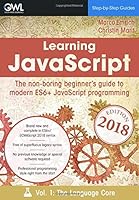Learning JavaScript: the Non-Boring Beginner's Guide to Modern (ES6+) JavaScript Programming Vol 2: DOM Manipulation
Select Format
Select Condition 
Book Overview
No Synopsis Available.
Format:Paperback
Language:English
ISBN:1983139149
ISBN13:9781983139147
Release Date:June 2018
Publisher:Independently published
Length:205 Pages
Weight:0.88 lbs.
Dimensions:9.6" x 0.5" x 6.7"
More by Christin Marit
Customer Reviews
6 customer ratings | 5 reviews
There are currently no reviews. Be the first to review this work.























